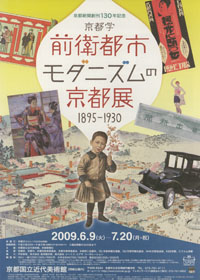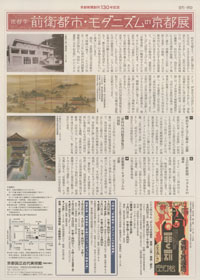Exhibitions130th Anniversary of the Kyoto Shimbun
Kyoto Studies: City of the Avant-Garde—Modernism in Kyoto
1895–1930
130th Anniversary of the Kyoto Shimbun
Kyoto Studies: City of the Avant-Garde—Modernism in Kyoto
1895–1930
HOME > Exhibitions > Kyoto Studies: City of the Avant-Garde—Modernism in Kyoto 1895–1930
In the year 794, the capital of Japan was moved from Nara to Heian-kyō, the present-day Kyoto, thus beginning the Heian period (794–1185) in Japanese history. Kyoto remained the Japanese capital until the Meiji Restoration in 1868, and continues to be regarded as a cultural center in Japan today.
Throughout the ages, the rich culture that has blossomed in Kyoto has repeatedly been examined from a variety of angles. In regard to modern art, for instance, there have been exhibitions focusing on the new trends in nihonga (Japanese-style painting) as seen in the painting circle in Kyoto; the new genre of yōga (western-style or oil painting) introduced in Kyoto by artists such as TAMURA Sōryū and ASAI Chū; the history of ‘tradition and revolution’ in ceramics, lacquerware, textiles, and other crafts; and the strong interest in western-style architecture, some examples of which can still be seen throughout the city. Such exhibitions have given shape to a ‘modern art in Kyoto.’
As it is well known, there has recently been a renewed interest in the history and culture of the city, as represented by the term “Kyoto Studies.” The present exhibition, however, will not merely reflect on such historical developments, but rather reconsider the multitude of cultures in ‘modern Kyoto’ from a new perspective.
The Fourth National Industrial Exposition was held in 1895 in Okazaki, the area in Kyoto where the National Museum of Modern Art, Kyoto stands today. At the same time and in the same area, Heian Jingū Shrine, designed by ITŌ Chūta, was built as a symbol of the festivities held in commemoration of the eleventh centenary of the movement of the capital to Heian-kyō. On the occasion of the purification ceremony of the building site of the shrine’s outer oratory, the Hinode Shimbun (the present Kyoto Shimbun) newspaper, which reached its 3000th issue the same year, made a gift of the Ō-torii—the largest torii (shrine gate) in Japan to this day—decorated with illuminations that represented the advanced hydrophobic and electric industry of that time, thus contributing to the festive mood. A few decades later, Okazaki was selected once again as the site for erecting a massive monument in the honor of Gottfried Wagener (1831–1892), the German chemist who played an important role in the advancement of crafts in Kyoto. As such, it may be no exaggeration to say that ‘modern Kyoto’ began right here in Okazaki.
Setting the starting point at the Fourth National Industrial Exposition, the exhibition will be based on the following sections:
1. Kyoto—The City of Meiji Modernism
2. The Impact of the Fourth National Industrial Exposition
3. Breaking New Ground in Crafts: Wagener’s Heritage
4. City of the Avant-Garde—Modernism in Kyoto
This exhibition will appropriately be held by the National Museum of Modern Art, Kyoto, located down the street from Heian Jingū Shrine, in tandem with the Kyoto Shimbun in celebration of their 130th anniversary. The organizers hope to present a vivid picture of Kyoto in full swing as a vanguard city of Modernism in the late nineteenth and early twentieth centuries.
-
Related events
- Exhibition dates
- Tuesday, June 9 – Monday (holiday), July 20, 2009
- Closed on Mondays
- Exception: Open on July 20 (Mon./holiday)
- Hours
- Regular hours
- 9:30AM–5:00PM (admission until 4:30PM)
- Evening hours (every Friday)
- 9:30AM–8:00PM (admission until 7:30PM)
- Notice on works on temporary display
- Please note that the following works will only be on display for part of the exhibition.
- Organizers
- The National Museum of Modern Art, Kyoto
- The Kyoto Shimbun Co., Ltd.
- Support
- Kyoto Prefecture
- Kyoto City
- Kyoto Prefectural Board of Education
- Kyoto Municipal Board of Education
- Kyoto Chamber of Commerce and Industry
- Kyoto Tourism Federation
- Kyoto City Tourist Association
- NHK Kyoto
- Kyoto Broadcasting System Company Limited
- Fm-Kyoto Inc.
- Cooperation
- Heian Jingū Shrine
- Shimadzu Corporation
- GS Yuasa Corporation
- Admission
- Advance tickets: Ticket Pia, FamilyMart (P code: 688-632), Lawson (L code:
- 59733), other major ticket vendors and convenience stores
- Publicity materials
- Flyer PDF (886KB)
Symposium: “One Form of Kyoto Studies: Art/Crafts/Architecture/City”
June 20 (Sat.), 2009 10:30AM–5:00PM
The National Museum of Modern Art, Kyoto (MoMAK)
1F Lecture hall (maximum capacity 100), free admission
Panelists: INAGA Shigemi (International Research Center for Japanese Studies),
SATŌ Kazunobu (Aichi Prefectural Ceramic Museum), FUJII Kenzō (Nishijin Textile
Center), MARUYAMA Hiroshi (Meijo University), YAMANO Hidetsugu (MoMAK)
Moderator: IKEDA Yūko (MoMAK)
Support: The Society for the Study of Japonisme
in Japanese only
Lecture: “Makino Films and Kyoto”
July 11 (Sat.), 2009 2:00PM–3:30PM
MoMAK 1F Lecture hall (maximum capacity 100), free admission
Lecturer: TOMITA Mika (Associate Professor, Ritsumeikan University Dept. of Image Arts
and Sciences)
in Japanese only
Film screenings: “City of the Avant-Garde: Modern Films in Kyoto”
July 10 (Fri.) & 11 (Sat.), 2009
MoMAK 1F Lobby (maximum capacity 200), 500 JPY per day
in Japanese only
Affiliated event: “City of the Cinema: Screenings of Avant-Garde Films Set in Kyoto”
July 2 (Thu.) & 4 (Sat.), 2009 1:30PM–, 5:00PM–
A Page of Madness (1926)
Shin Kankaku-ha Eiga Renmei (93 min.) / Original screenplay: KAWABATA Yasunari
Director: KINUGASA Teinosuke
July 3 (Fri.) & 5 (Sun.), 2009 1:30PM–, 5:00PM– (2 works shown together)
A Brook: Following the Stream (1934)
Cine Front Kioto (13 min.) / documentary film / Director: NOSE Katsuo
Crossroads (1928)
Kinugasa Productions (65 min.) / Director: KINUGASA Teinosuke
The Museum of Kyoto 3F Movie Hall
| June 30 (Tue.) – the end of the exhibition | |
|---|---|
| IV-30 | Electric car: “Detroit” |
| the beginning of the exhibition – July 12 (Sun.) | |
| I-27 | KURODA Seiki: Study for Talk on Ancient Romance (Composition II) |
| I-28 | KURODA Seiki: Study for Talk on Ancient Romance (Maiko) |
| I-29 | KURODA Seiki: Study for Talk on Ancient Romance (Waitress) |
| I-30 | KURODA Seiki: Study for Talk on Ancient Romance (Man and maiko) |
| I-31 | KURODA Seiki: Study for Talk on Ancient Romance (Seikan-ji Temple gate) |
| Day of admission | Advance | Group (20 or more) | |
|---|---|---|---|
| Adult | 1200 | 1000 | 900 |
| University students | 900 | 700 | 600 |
| High school students | 500 | 300 | 200 |
| Junior high and younger | Free | Free | Free |


Top of this page




